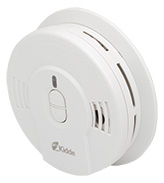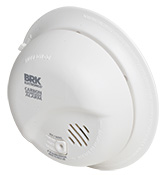Smoke Alarm Buying Guide
Smoke alarms save lives—if installed and working properly. It's important to choose the right smoke detectors for your property, know where to place them, and how to keep them in good working order.
Ionization vs. Photoelectric Smoke Alarms
There are two common types of smoke alarms on the market today—ionization and photoelectric smoke detection. Each technology delivers lifesaving smoke detection in different ways. Experts in the fire protection and prevention industry don't recommend one over the other.
The two types of sensors operate and respond differently depending on conditions. Since you can't know the type of fire that will occur, installing both types of alarms will only improve fire safety preparedness.
Ionization Smoke Detectors:

- Detect smaller, less visible fire particles
- May respond slightly faster to flaming fires such as paper or wood fires and candles
- Best for areas with highly combustible materials like flammable liquids, newspapers, paint, or cleaning chemicals
How they work:
Ionization smoke alarms depend on a small amount of radioactive material to ionize the air in the sensing chamber. When smoke enters the chamber, the particulates disrupt the flow of ions, and the alarm is activated. Because of their sensitivity, ionization smoke alarms should not be placed too close to kitchens and bathrooms. Vapors from cooking and showers have been known to set off false alarms.
Shop Ionization Smoke DetectorsPhotoelectric Smoke Alarms:

- Detect larger, more visible fire particles
- May respond better to smoldering fires
- Best for living areas, bedrooms, rooms with large furniture, such as sofas, mattresses, or counters, that would burn slowly
How they work:
Photoelectric smoke alarms use light sensitivity to detect the presence of smoke. When smoke enters the sensing chamber, scattered light is reflected onto the sensor and the alarm is triggered.
Shop Photoelectric Smoke AlarmsInstallation & Maintenance Tips
- Smoke alarms should be installed inside and outside each sleeping area and on every level.
- Comply with any smoke alarm legislation in your state.
- Test all smoke alarms at least once a month.
- Replace all smoke alarms when they are 10 years old or as recommended by the manufacturer.
- Always be prepared for an emergency. Review these fire emergency preparedness tips.
